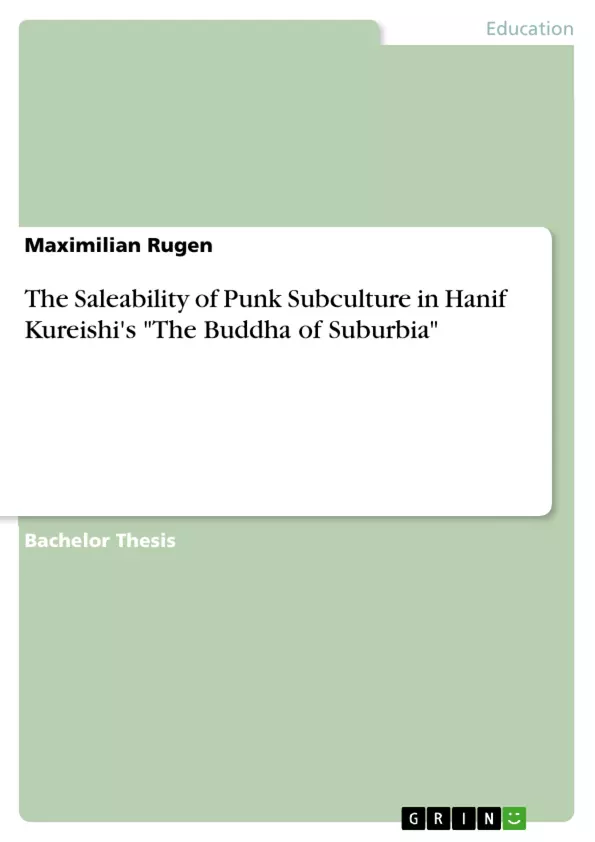The Buddha of Suburbia is a novel set in London in the late 1970s. On the verge of hippie culture, popular discontent and disorientation lead to a more nihilistic and destructive approach of cultural identity, namely punk. More and more people start to dress themselves in black, ripped clothes, attempting to revolt against conformity and the machinery of consumerism. The narrative is centred around Karim Amir, an Indo-British teenager whose family is disintegrating due to the fading connection between his parents.
“His father’s escape from this disaster is to become The Buddha of Suburbia, mouthing trite Indian spiritual sayings for desperate middle aged suburbian housewives and the like.” It is due to the developing romance between his father and one of his hippie fellows, that Karim is eventually “introduced into the whirlwind of London punk and social life and then thoroughly swept along the tide, ultimately achieving a measure of personal success as all around him flounder in overindulgent self-indulgence.”
Though beginning “with the left-overs of the hippie generation, the novel ends not even a year later; punk, however, has already been bitten, swallowed, and spat out.” Consequently, The Buddha of Suburbia addresses two subcultures, the hippies and the punks. Even though both are viewed “as superfluous and too willing to sell their values for the consumption of mainstream society”, they ironically end up becoming embodiments of popular entertainment. This development of a radical subculture embracing a marginalised position in society towards a mainstream culture, deserves to be investigated thoroughly.
Table of Contents
- Introduction: 'Cool' Merchandise
- Comment on Terminology: Punk - a Subculture, a Movement?
- London Punk and Punk Values
- The Emergence of London Punk
- Performing Punk Identity
- The Popularity of 'Cool'
- Punk in Hanif Kureishi's The Buddha of Suburbia
- Charlie Hero
- Karim Amir
- Conclusion: Punk Sells.
Objectives and Key Themes
This paper examines the saleability of punk subculture in Hanif Kureishi's novel The Buddha of Suburbia, set in London during the late 1970s. The research aims to analyze how the novel portrays punk's transition from a radical subculture to a mainstream trend, exploring the tension between punk's anti-consumerist ideology and its ultimate commodification.
- The emergence and evolution of punk subculture in the context of 1970s London, considering its relation to hippie culture.
- The performative nature of punk identity and its potential for commodification.
- The role of individuals like Charlie Hero in the popularization and commodification of punk.
- The intersection of punk subculture with colonialism and its impact on cultural identity.
- The complexities of defining "subculture" and "counterculture" in relation to punk.
Chapter Summaries
The introduction sets the stage by introducing the novel's setting and the central theme of punk's commodification. It highlights the contrast between punk's anti-consumerist ideology and its eventual embrace by mainstream culture.
Chapter 2 delves into the terminology surrounding punk, discussing the often interchangeable terms "subculture" and "counterculture." The chapter explores the challenges in defining "subculture" and provides a working definition for the purposes of the paper.
Chapter 3 examines the emergence and evolution of London punk. It explores the historical context of the movement, including its relationship to hippie culture, and analyzes the factors contributing to punk's rapid demise in the late 1970s.
Chapter 4 focuses on the depiction of punk in Kureishi's novel, analyzing the characters of Charlie Hero and Karim Amir. This chapter examines how the novel portrays the tension between punk's anti-consumerist ideals and its eventual commercialization.
Keywords
The key terms and focus topics of this paper include punk subculture, counterculture, consumerism, commodification, identity, performance, colonialism, and cultural trends. The research examines the evolution of punk from a radical movement to a mainstream trend, analyzing the factors contributing to its commodification in the context of Hanif Kureishi's The Buddha of Suburbia.
- Quote paper
- Maximilian Rugen (Author), 2017, The Saleability of Punk Subculture in Hanif Kureishi's "The Buddha of Suburbia", Munich, GRIN Verlag, https://www.grin.com/document/1152516



